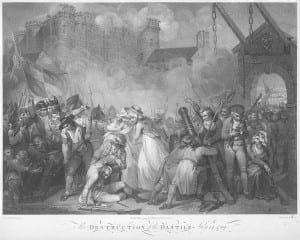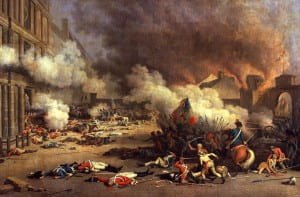From Agitation to Bloodbath: The Evolution of Violence during the French Revolution
The events leading up to the revolution were brought on by the extreme differences in the lifestyles between the first and second estates, the clergy and nobility, and the third estate, which was 97% of the citizenry. These differences included the wildly extravagant lifestyles of the nobility which seemed to flaunt their wealth in the faces of the common people. The French economy was in shambles from previous wars and from its monetary support for the United States during the American Revolution. The majority of noble landowners and the church were exempt from taxation, whereas the Third Estate was expected to pick up the tab. The people were also frustrated with the representation it had in government. These frustrations, combined with a crop failure in 1788, added to the misery of the people by inflating the price of food, mainly bread, and led to riots in many villages (Hibbert, 91). These riots led to assaults on millers, farmers, and gamekeepers who were suspected of hoarding grain or animals for slaughter. The Bishop of Agde was forced by a crowd to give up his rights to a mill, while some mayors and other community leaders were forced to resign their positions. A few cases of murder were also known to have happened, such as the mayor of Troyes and an Army officer in the city of Caen being killed (Hibbert, 91). Frustrations heightened and would ultimately lead to a mob mentality on behalf of the citizens as they sought to alleviate some of their immediate problems, including stealing weapons and overthrowing small prisons.
The Destruction of Bastille by William Nuitter
The storming of the Bastille on 14, July 1789 was the symbolic beginning of the French Revolution. Citizens, and some soldiers, rose up and attacked this French symbol of authority and oppression as well as being a source of weapons and gunpowder. During the assault, both soldiers and citizens were killed. However, the incident that seemed to escalate the degree of violence was when the commander, Bernard René de Launay, was killed even though he had surrendered honorably, and his decapitated head placed on a pike and paraded through the streets (Silva- Grondin). With this act we see that the violence is beginning to evolve, becoming something more than just violence committed in an act of the moment. Instead, it is evolving into something of a spectacle ruled by the whim of the mob.
After this symbolic attack, the revolutionaries seized control of the government and of King Louis XVI himself. Though the King retained his status, he held very little, if any, power over any institution of government. By the summer of 1792, with the people demanding punishment of the King, exclaiming “liberty for all”, and “emancipation for the people”, the violence was once more going to escalate. On 10 August 1792, the King’s Swiss Guard at Tuileries Palace were massacred when citizens and members of the National Guard marched on the Palace. More than 500 Swiss guards were slaughtered during the ensuing battle while the attackers deaths numbered close to 300 (Hibbert, 161).
La Prise du palais des Tuileries by Jacques Bertaux
This attack turned out to be extremely vicious because no mercy was shown to any of the members of the Swiss Guard or anyone else found in the Palace. When members of the Swiss Guard attempted to surrender they were hacked down with swords or bayonets, or thrown out windows and had their heads then impaled on pikes. The mob developed an insatiable bloodlust that cause them to kill not only the armed and unarmed soldiers, but also everyone they found in the Palace including ushers, doorkeepers, cooks, and maidservants (Hibbert, 160).”One witness saw ‘some very young boys playing with human heads’; another heard ‘an honest artisan’ remark, ‘Ah, Monsieur. Providence has been very good to me! I killed three of the Swiss with my own hands (Hibbert, 160)! ” From here the violence had become a spectacle that creates a maniacal joy in the participants while driving away any thought of mercy and compassion.
[poll id=”4″]
The days of terror were a further escalation of the violence that became not only socially accepted, but a means of justice, perverted though it was. Maximilien Robespierre and his fellow Jacobin leaders instituted a government policy of executions for all of those who violated the “will of the people”; of course, the “will of the people” was decided by Robespierre. This “will of the people” led to the wide use of the guillotine as the means of enacting justice. Those that fell under the blade were often guilty of nothing more than not showing enough enthusiasm for the cause of the revolution.
“‘The whole country seemed one vast conflagration of revolt inventions,’ wrote William Hazlitt in a passage characteristic of English writers of his time and temperament. ‘The shrieks of death were blended with the yell of the assassin and the laughter of buffoons. Never were the finest affections more warmly excited or pierced with more cruel wounds. Whole families were led to the scaffold for no other crime than their relationship; sisters for shedding tears over the death of their brothers in the emigrant armies; wives for lamenting the fate of their husbands; innocent peasant girls for dancing with the Prussian soldiers; and a woman giving suck, and whose milk spouted in the face of her executioner at the fatal stroke, for merely saying as a group were being conducted the slaughter, ‘Here is much bloodshed for a trifling cause’” (Hibbert, 226).
[poll id=”3″]
In some of the provinces away from the city of Paris, other disturbing acts of violence were taking place. In Lyons, Collot d’Herbois and Joseph Fouche came to the conclusion that the guillotine was too slow. Instead, they lined up their victims in front of cannons and mowed them down with grape shot, a type of ammunition that essentially turns a cannon into a large shotgun. In the city of Nantes, Jean Baptiste Carrier was in charge of 5000 prisoners. 3000 were left to starve or succumb to illness in prison while another 2000 were taken on barges to the middle of the Loire River, chained together in pairs and thrown overboard (Hibbert, 227). The bloodlust and outright murder appeared to be driving some men insane. Carrier was heard to be raving to himself about “the need to kill and kill”, and to “butcher children without hesitation” (Hibbert, 228). In Arras, a former priest, Joseph le Bon, traveled among the smaller cities with his guillotine and his authority. Apparently, enjoying the spectacle of the deaths and the grimaces of his victims so much that he attended every execution and ordered a band to play festival type music for the benefit of himself and the crowd. Afterward, he would often invite the executioner to dine with him and would recall the facial expressions of the condemned to his wife. With all the violence and death that are taking part during this time, we see that some of the people take a hideous enjoyment in the death and the rivers of blood that flowed throughout France during the Days of Terror. We also see that some of the people with authority have lost their minds and in perpetrating so much death.
”In Paris thousands of people went out regularly to witness the operations of what the deputy, J. A. B. Amar, called the ‘red Mass’ performed on the ‘great altar’ of the ‘holy guillotine’ (Hibbert, 129). For many it seems that the bloodlust in the violence had created its own religion to replace the absence of the Catholic Church in France. Still, many people were becoming disgusted with the continuing violence and death surrounding the daily life in many of the French towns and districts. By July 1794, the people were demanding an end to the widespread violence and executions. Indeed, Robespierre was viewed as a dictator and ultimately became a victim of the very mechanism of death that he had instituted and fed. Most of the other Jacobins that held authority over life and death were also executed. The Days of Terror had ended but the revolution was still not over. A page had been turned and the overwhelming days of institutionalized violence had ended, but the revolution would continue for 5 more years until the rise of Napoleon Bonaparte. Still, the violence would continue but reverting more towards that of the mob until Napoleon’s power took control.
[poll id=”5″]



